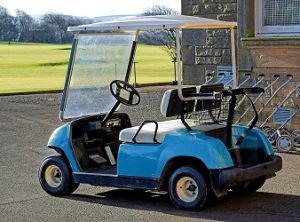Golf carts are commonly used for transportation on golf courses, but they can also be used for other purposes such as personal transportation, maintenance, and security. Electric golf carts have become increasingly popular due to their efficiency, quiet operation, and low emissions. But how does an electric golf cart work? Let’s take a closer look.
The Battery and Charger
The battery used in an electric golf cart is typically a deep cycle lead-acid battery, which is designed to provide a steady flow of power over a long period of time. These batteries are similar to the ones used in cars, but they are designed to be discharged and recharged many times. The battery is connected to the charger, which uses an AC power source to convert the electricity into a DC current that is used to charge the battery.
The Motor and Controller
The motor used in an electric golf cart is typically a DC motor, which is very efficient and provides good torque for its size. The motor is connected to the rear axle of the golf cart and drives the wheels through a series of gears. The controller regulates the amount of power that is sent to the motor, based on the position of the accelerator pedal. The controller also monitors the temperature of the motor and battery, and will shut off the power if they get too hot.
The Steering and Brakes
The steering system used in an electric golf cart is typically rack-and-pinion, which is a simple and efficient design that provides good control and accuracy. The driver turns the steering wheel, which rotates a gear that is connected to a pinion gear. The pinion gear is connected to a rack that moves the front wheels left or right.
The brakes used in an electric golf cart are typically hydraulic disc brakes, which provide good stopping power and are easy to maintain. The brakes are activated by pressing down on the brake pedal, which causes the brake pads to press against the disc rotor. Some electric golf carts also use regenerative braking, which is a system that captures energy from the motor when the brakes are applied and uses it to recharge the battery.
Accessories
Electric golf carts can be equipped with a wide variety of accessories, depending on the intended use of the cart. Common accessories include headlights, taillights, turn signals, mirrors, and horns. Some golf carts may also be equipped with weather enclosures, heaters, and air conditioning units for comfort in extreme temperatures.
Overall, electric golf carts are a great choice for transportation in a variety of settings, thanks to their efficiency, low maintenance requirements, and ease of use. With the right battery and charger, a good motor and controller, and well-designed steering and brake systems, an electric golf cart can provide years of reliable service for many different applications.
Components of an Electric Golf Cart
| Component | Function | Example | Material | Location |
|---|---|---|---|---|
| Motor | Powers the golf cart and drives the wheels | DC motor | Copper wire, magnets | Underneath the seat |
| Battery | Provides power to the motor | Lithium-ion battery | Electrolyte, Cathode, Anode | Underneath the seat |
| Controller | Regulates the amount of power sent to the motor | Solid-state controller | Silicon, copper, aluminum | Dash area |
| Charger | Recharges the battery when low on power | On-board charger | AC to DC transformer, rectifier | Near the battery |
| On/Off Switch | Controls the flow of electricity to the cart | Key switch | Plastic, metal, copper | Dash area |
Operating the Electric Golf Cart
| Action | Function | Example | Location | Duration |
|---|---|---|---|---|
| Press Accelerator Pedal | Sends power from battery to motor | Foot on the pedal | Floor area | Variable |
| Release Accelerator Pedal | Disengages power from motor | Foot off the pedal | Floor area | Variable |
| Press Brake Pedal | Engages the brake and stops the cart | Foot on the pedal | Floor area | Variable |
| Release Brake Pedal | Disengages the brake and allows the cart to move | Foot off the pedal | Floor area | Variable |
| Turn Steering Wheel | Changes the direction of the cart | Hand on the wheel | Steering column | Variable |
Golf Cart Performance Metrics
| Metric | Function | Example | Calculation | Units |
|---|---|---|---|---|
| Range | How far the golf cart can travel on a single charge | 50 miles | Battery capacity x efficiency | Miles |
| Top Speed | Maximum speed the golf cart can reach | 25 mph | Motor capacity x gearing | mph |
| Horsepower | The amount of power the motor can generate | 4 hp | Voltage x Amperage | hp |
| Torque | The force that moves the golf cart forward | 30 Nm | Motor capacity x gear ratio | Nm |
| Charging Time | How long it takes to recharge the battery | 6 hours | Battery capacity / Charging rate | hours |
Golf Cart Safety Features
| Feature | Function | Example | Material | Location |
|---|---|---|---|---|
| Seat Belts | Keeps passengers secure in the event of an accident | 3-point seat belt | Nylon, metal | Seats |
| Rearview Mirror | Provides a view of what’s behind the cart | Convex mirror | Glass, plastic | Windshield |
| Headlights | Illuminates the path ahead in low-light conditions | LED headlights | Plastic, metal | Front of cart |
| Turn Signals | Signals when the cart is turning | Blinker lights | Plastic, metal | Front and back |
| Parking Brake | Keeps the cart in place when parked | Hand brake lever | Plastic, metal | Floor area |


